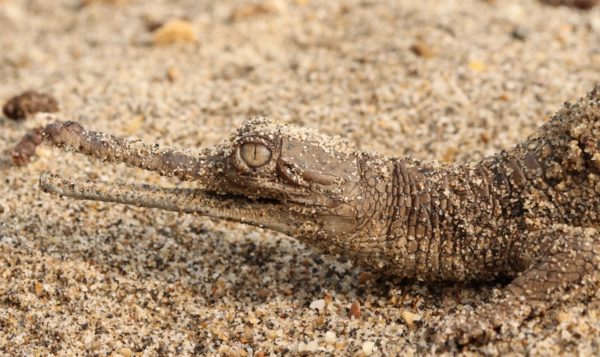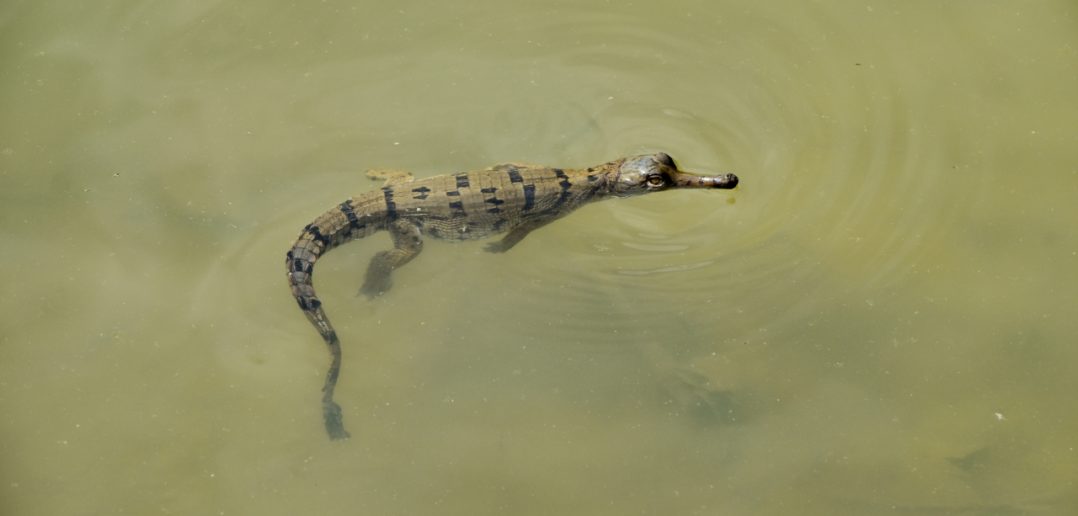There is new hope for the Critically Endangered gharial crocodile after conservationists from ZSL (Zoological Society of London) and Biodiversity Conservancy Nepal discovered more than 100 hatchlings in Bardia National Park in South West Nepal this year.
This is the first recorded breeding in the National Park since 1982.

The species has suffered a 98% decline since the 1940s, due to a variety of human-induced threats.
Only one other population is known to be breeding in the entirety of Nepal, in Chitwan National Park, where ZSL is also working with local communities to help improve numbers in the wild.
The discovery means conservationists can now prioritise this population for conservation action, including conducting feasibility studies into whether the species can be translocated from the south in Chitwan and researching survival rates of hatchlings.
Gharials (Gavialis gangeticus), ranked #17 on ZSL’s EDGE (Evolutionary Distinct and Globally Endangered) Reptiles list are primitive and bizarre in appearance – with extremely long slender snouts and disproportionately sized heads to bodies, they are unmistakable but also severely threatened. With fewer than 100 adults remaining in Nepal, several fragmented populations in India and virtually extinct across the rest of their former range – they are among the world’s most endangered reptiles.
“Understanding whether gharials were breeding in Bardia National Park was considered to be a top priority for the species, as upcoming plans to divert nearby river systems –which would likely have an impact on the habitat and quality of the river for gharial, are currently underway,” said Rikki Gumbs, ZSL’s EDGE of Existence PhD Researcher. “Given the species is limited to around five populations across its entire range, this is such a positive discovery, and a critical step for the long-term recovery of the species in Nepal.”
The dramatic declines seen in gharials were initially caused by river modification with dams and barrages fragmenting habitat, and as accidental bycatch when they drowned in fishing nets. Over-hunting for skins and egg collection were also major issues. Although hunting and egg collection are now prohibited, additional threats today include the overwhelming and irreversible loss of riverine habitat due to construction of dams, irrigation canals, sand-mining, pollution and agriculture.
In the last 50 years, Nepal has lost almost twice as many freshwater species than terrestrial species – but this is not an issue only for Nepal, this is a phenomenon seen around the world, occurring at an astonishing rate.
For gharials, these changes have meant hatchlings aren’t making it to adulthood and being recruited into the population. Gharial travel large distances in search of suitable locations for feeding, breeding and nesting. This makes them susceptible to being isolated from suitable habitat since they can be trapped on the wrong side of dams and barrages when monsoon floodwaters go down. They’re also highly susceptible to human disturbance, which is increasing due to lowland areas becoming urbanised.
Communities around National Parks in Nepal also face their own challenges, however, with hundreds of thousands of people heavily dependent on natural resources for their day-to-day lives, relying on fishing for their livelihoods and food. However, fish stocks are slowly being depleted, impacting both gharial and local people.
ZSL has been working within local communities to set up ‘Gharial Guard Groups’ outside of Chitwan National Park in order for them to patrol and protect gharials from direct threats such as unsustainable fishing. Further funds from ZSL’s UK Aid Match appeal (which sees the UK Government double each donation given to ZSL, up to £2million by 31 December 2019), will help create the climate needed to continue plans to conserve the gharial.
“After trekking through the jungle for hours to sit on a ridge and finally catch a glimpse of the hatchlings below us – it was an incredible moment to capture,” said Ashish Bashyal, Project lead and National Geographic Photo Ark EDGE Fellow based in Nepal. “At around 30cm in size, they look exactly like miniature versions of adult gharials – so incredibly cute.
“People generally have a great affinity for gharials, they don’t attack humans as they generally feed on fish – and their snout is much too fragile. We want to try and harness that love for the animal into local community conservation action in order to help monitor how the hatchlings fair.”
Experts are keen to stress that while this news is exciting, the species still requires urgent conservation action and much needed funds. Read the full report here (on pages 10 and 11).




